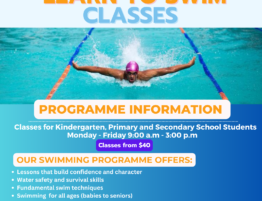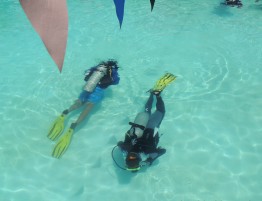
6 Months to 1 Year
Tempted to rush out and sign up your little one for swimming lessons this summer? That’s a smart move — if he’s old enough. The American Association of Pediatrics recommends that parents hold off on formal swimming lessons until after their child’s fourth birthday, when he’s developmentally able to learn the skills needed to stay afloat. Until then, consider a parent-child program that focuses on water games, swimming-readiness skills, and safety in and around the pool. Along with age, take your child’s experience and comfort with water into account before you sign up for any class. “While no course can ‘drownproof’ a child, a progressive learn-to-swim program can provide your child with skills that will last a lifetime,” says Connie Harvey, national health-and-safety expert for the American Red Cross. Here’s how to help your child take to the water like a fish.
Lessons
At this age, you simply want to introduce your child to the water. You can play in the pool with her yourself or join a class that’s about having fun and getting comfortable in the water — not learning to swim. Activities may include showing her how to splash, singing songs while bobbing around, and playing gentle games together.
Safety Savvy
- Keep your baby in your arms at all times.
- Do not submerge any child under 3. Kids this age can swallow a large amount of water — enough to dilute the chemicals in their blood, causing sleepiness, nausea, and seizures. In rare cases, water intoxication can be fatal.
- Dress her in a swim diaper that prevents fecal matter from leaking into the pool — a major health risk for other swimmers.
- If you own a pool, it should be fenced in on all sides and have a self-closing, self-latching gate that’s out of your child’s reach. The fence should be four to five feet high and should not have any footholds.
- An infant can drown in as little as an inch of water in less than 30 seconds, so beware of all water hazards, including inflatable baby pools, buckets, toilets, and tubs.
- Keep rescue equipment — for example, a plastic ring buoy, a reaching pole, a first-aid kit, and a portable phone — near the pool.
2 to 3 Years
Lessons
Your curious tot will be more active in the water — though he will definitely still need you or another adult to hold him. In your pool or swimming program, play fun games that require him to move his arms (throw a ball across the pool and have him reach for it, for example), kick his legs, and float supported on his stomach or back. Show him how to blow bubbles in the water so he’ll learn to get his face wet without swallowing water. By the time he’s 3, he may be able to do many of these things with little help from you.
Safety Savvy
- Your toddler may now feel so comfortable in the water that he thinks he can swim by himself. Don’t leave him alone, even for a minute. He needs constant adult supervision around water.
- Make sure the pool gate is always closed and the lock is out of reach.
- Stress basic pool safety, like not running near the pool and only going into the water with Mommy or Daddy.
- Avoid water wings, air-filled swimsuits, and inflatable flotation toys. He’ll sink if they deflate, and they may give him — and you — a false sense of security. If you want to use a flotation device, buy a U.S. Coast Guard-approved life jacket.
- Don’t leave toys in the pool after he gets out. He may be tempted to reach for them.
4 to 5 Years
Lessons
Now that your child is developing the coordination necessary to learn to swim by herself, you can enroll her in formal swimming lessons. If she doesn’t have much experience in the water, look for a program that helps her get comfortable. You may be able to take part in her first class to make the transition easier for her. In the shallow water, she should be able to learn how to float independently, submerge her head under the water for five to ten seconds, go from a standing to a swimming position without assistance, glide through the water, and use coordinated kicking and arm movements. She should learn water safety as well as water skills.
Safety Savvy
- Even though you don’t have to hold your child, you or the instructor should practice “reach supervision” by being in the water and within reaching distance.
- Be patient. Your child may be a fish one day and afraid of the water the next. Don’t force her to do an activity until she’s ready.
- Make sure your pool has the deep and shallow ends marked. A lifeline separating the two ends is a good idea.
- Never assume another adult is watching, even if a lifeguard is present.
- Some children hate to get their face wet. Practice at home by encouraging her to put her head under the shower spray.
6 Years and Up
Lessons
An older child can hold his breath for longer periods of time, swim underwater, and retrieve objects at the bottom. He will be able to jump into the water and resurface on his own. He can start learning all of the swimming strokes, including the breast- and backstroke. His greater endurance will allow him to swim longer distances. At this point, you don’t have to be in the water with your child, but you still need to supervise pool activities, as he might overestimate his abilities.
Safety Savvy
- Have an adult watch all water activities. Even a good swimmer can drown.
- Make it a rule that your child can swim only when an adult is present, and encourage him to always swim with a buddy.
- Teach him to dive only when an adult is watching and the water is deep.
- You should be extra vigilant at the beach or a lake. A child’s swimming skills in a pool don’t necessarily translate to open water.
- Always make your child wear a life jacket when boating or waterskiing, even if he can swim.







